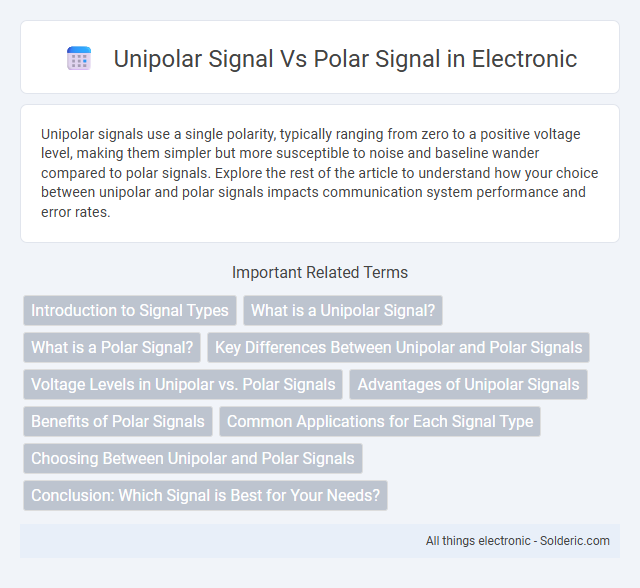Unipolar signals use a single polarity, typically ranging from zero to a positive voltage level, making them simpler but more susceptible to noise and baseline wander compared to polar signals. Explore the rest of the article to understand how your choice between unipolar and polar signals impacts communication system performance and error rates.
Comparison Table
| Aspect | Unipolar Signal | Polar Signal |
|---|---|---|
| Voltage Levels | Positive voltage and zero | Positive and negative voltages |
| Signal Range | 0 to +V | -V to +V |
| Power Efficiency | Lower power efficiency | Higher power efficiency |
| Noise Immunity | Lower noise immunity | Better noise immunity |
| DC Component | Present (causes baseline shift) | Usually zero DC component |
| Application | Simple digital circuits, TTL logic | Communication systems, balanced signaling |
| Complexity | Simple implementation | More complex circuitry |
Introduction to Signal Types
Unipolar signals use a single polarity level, typically ranging from zero to a positive voltage, making them simpler but less efficient in noise immunity and error detection. Polar signals employ both positive and negative voltage levels, enhancing signal clarity and reducing the likelihood of errors in digital communication systems. The choice between unipolar and polar signaling impacts the performance metrics such as power consumption, bandwidth utilization, and signal-to-noise ratio in data transmission.
What is a Unipolar Signal?
A unipolar signal is an electrical signal that varies between zero and a positive voltage level without crossing the zero baseline, commonly used in digital circuits where the signal represents binary data with presence or absence of voltage. Unlike polar signals that switch between positive and negative voltages, unipolar signals maintain a single polarity, simplifying circuit design and reducing power consumption in specific applications. This characteristic makes unipolar signaling advantageous for systems requiring straightforward interpretation of logic states, such as in basic pulse amplitude modulation (PAM).
What is a Polar Signal?
A polar signal uses two voltage levels representing binary data, typically positive and negative voltages, to transmit information efficiently with better noise immunity. Unlike unipolar signals that use only one polarity referenced to zero, polar signals provide higher energy efficiency and improved signal-to-noise ratio. Your communication system can benefit from polar signaling by reducing error rates in digital data transmission.
Key Differences Between Unipolar and Polar Signals
Unipolar signals use only one polarity level, typically ranging from zero to a positive voltage, whereas polar signals utilize both positive and negative voltage levels, centered around zero. Unipolar signaling is simpler and consumes less power but is more susceptible to baseline wander and noise, while polar signaling offers better noise immunity and reduced DC component. Common applications of unipolar signals include digital logic circuits, whereas polar signals are often employed in communication systems to enhance signal integrity.
Voltage Levels in Unipolar vs. Polar Signals
Unipolar signals use a single voltage level, typically ranging from 0 to a positive value, representing binary data with zero voltage for one state and a positive voltage for the other. Polar signals utilize two voltage levels, positive and negative, such as +V and -V, effectively representing binary data with a wider voltage range that improves noise immunity. Your choice between unipolar and polar signals affects signal integrity and power efficiency in digital communication systems.
Advantages of Unipolar Signals
Unipolar signals offer the advantage of simpler circuit design due to their single polarity voltage levels, which reduces hardware complexity and power consumption. These signals are easier to generate and detect, making unipolar signaling ideal for short-distance digital communication where noise resilience is less critical. The straightforward encoding in unipolar signals results in cost-effective implementations compared to polar signals that require two voltage levels.
Benefits of Polar Signals
Polar signals offer improved noise immunity and better signal-to-noise ratio compared to unipolar signals, enhancing communication reliability. They enable more efficient use of bandwidth and power, leading to reduced error rates in digital transmission systems. Polar signaling also supports easier implementation of differential signaling techniques, which further minimize interference and signal distortion.
Common Applications for Each Signal Type
Unipolar signals are commonly used in digital logic circuits, such as microprocessors and memory devices, where voltage levels represent binary states with a single polarity. Polar signals find widespread application in communication systems and data transmission, benefiting from their ability to represent binary data with both positive and negative voltage levels, improving noise immunity and signal integrity. Industrial control systems and instrumentation often employ unipolar signals for simplicity, while polar signals are preferred in high-speed serial communication protocols like Ethernet and USB due to their enhanced performance characteristics.
Choosing Between Unipolar and Polar Signals
Choosing between unipolar and polar signals depends on your communication system's requirements, such as noise immunity and power efficiency. Unipolar signals use a single voltage level for data transmission, which simplifies hardware but is more susceptible to noise. Polar signals, with positive and negative voltage levels, provide better noise resistance and improved signal integrity, making them ideal for long-distance or high-speed communication.
Conclusion: Which Signal is Best for Your Needs?
Unipolar signals, characterized by their single polarity and simpler circuitry, are ideal for applications requiring low power consumption and ease of implementation, such as digital logic circuits. Polar signals, featuring both positive and negative voltage levels, provide better noise immunity and higher signal integrity, making them suitable for long-distance communication and high-speed data transmission. Choosing the best signal depends on specific requirements like power efficiency, noise tolerance, and the complexity of the application environment.
unipolar signal vs polar signal Infographic

 solderic.com
solderic.com